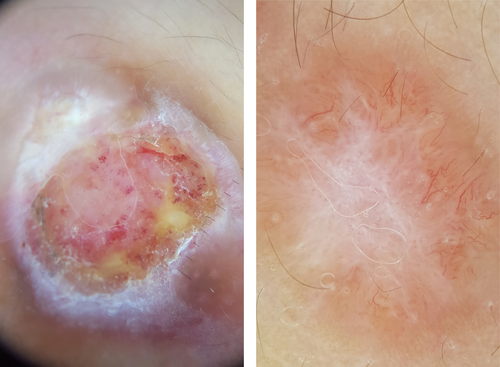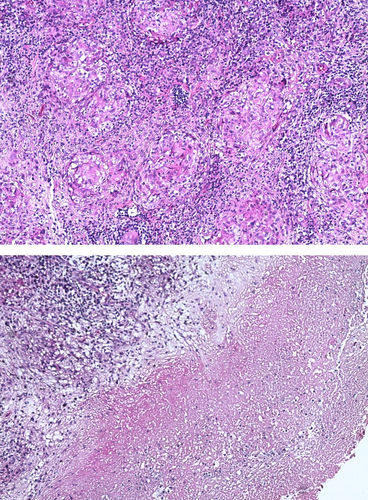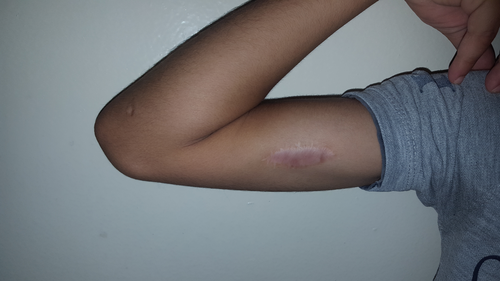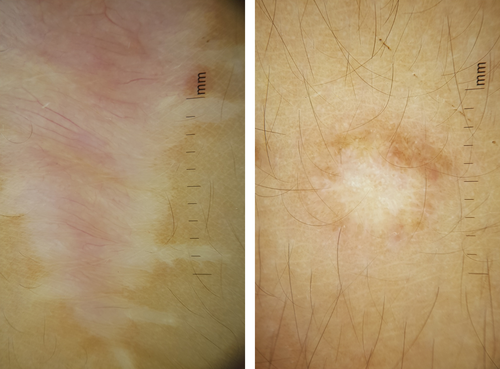Sporotrichoid-like tuberculosis in a child: Unusual clinico-dermoscopic aspect
Abstract
Tuberculosis- child - Sporotrichoid - clinical image - dermoscopic image- correlation.
Cutaneous tuberculosis simulating sporotrichosis has been sporadically reported; it mainly affects children after post-traumatic inoculation.1 We describe a new pediatric case of gummy tuberculosis with a sporotrichoid pattern, as well as its dermoscopic appearance.
A child of 10 years, who has been vaccined by BCG just 1 week after born, presented since 4 months, with two lesions on his right arm. On examination, it was the primary nodule formed two erythematous nodules developed subsequently over his right arm in a linear distribution, simulating sporotrichosis. The oldest was ulcerated at its center, well defined, with regular accentuated borders (Figure 1A). Dermoscopically, the lesion exhibits a linear and hairpin vessels, and whitish reticular streaks at the periphery (Figure 2A). The recent plaque was erythemato-squamous, well limited (Figure 1A), with linear and hairpin vessels on dermoscopy (Figure 2B). Unilateral axillary lymph nodes were involved with a 3 cm, firm and mobile lymphadenopathy. A skin and lymph node biopsy were performed. The histopathology of the primary nodule disclosed dermal epithelioid cell granuloma with caseation necrosis and peripheral lymphocytic infiltration (Figure 3). Ziehl-Neelsen, periodic acid-Schiff or Grocott's staining did not provide any additional positive information. The primary clinical differential diagnosis included sporotrichosis and leishmaniasis sporotrichosis-like. We started antituberculosis drugs for 6 months. After the initiation of the therapy, his cutaneous lesions rapidly subsided with some residual scar formation (Figures 4 and 5).





Cutaneous tuberculosis with sporotrichoid pattern is exceptional; it may be observed in young people following post-traumatic inoculation.1 Typically the lesions have a linear (lymphatic) arrangement as a result of lymphatic spread of the infection from a primary entry focus in the skin. The unique clinical presentation of the cutaneous tuberculosis should be kept in mind in the differential diagnosis of sporotrichosis-like skin lesions, especially in elderly immunocompromised patients.2 Dermoscopy is a noninvasive diagnostic tool that recently has been discovered to assist also the clinical diagnosis of infectious skin diseases. However, dermoscopy of cutaneous tuberculosis is less reported and concerned mainly the lupus vulgaris, with typically the yellow to golden-colored background and linear vessels.3 New features were revealed in our case, such as peripheral hairpin vessels and whitish streaks. This observation requires further confirmation on a larger series of cases of cutaneous tuberculosis. Cutaneous tuberculosis mimicking sporotrichosis is rare, and the diagnosis remains difficult and must be based on clinical-dermoscopic and histological arguments. Nevertheless, it must be mentioned before any sporotrichoid lesion especially in an endemic country such as Morocco.
CONFLICT OF INTEREST
No conflicting interest.
AUTHOR CONTRIBUTION
CSH: is a corresponding author of the manuscript. HB: supervised the manuscript. JZ: involved in photograph taking. MR: contributed to histological examination. FZM: supervised the manuscript.




